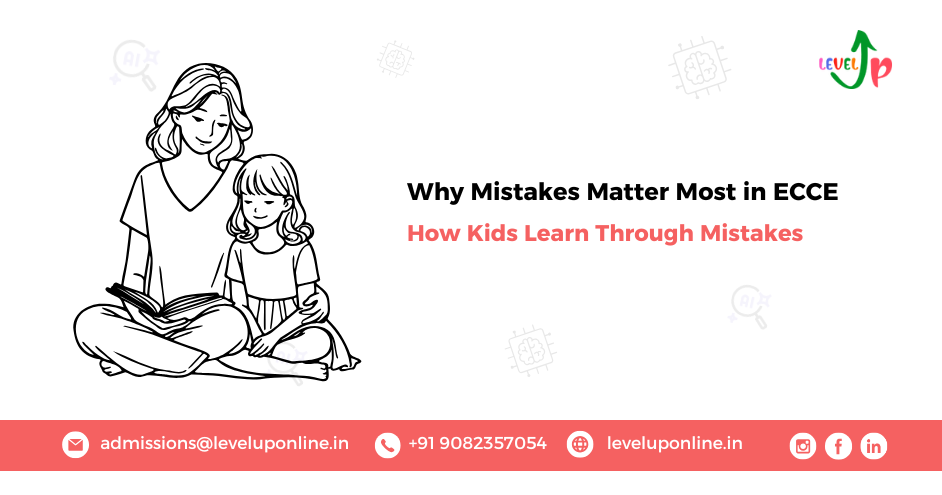Introduction
Ever wondered why your little one keeps getting the same puzzle piece wrong? Or why they stumble over the same word every time? It can be frustrating—but what if we told you those very moments are exactly what builds a strong foundation for learning?
In the world of ECCE (Early Childhood Care and Education), mistakes are not just common—they’re critical. This blog unpacks why mistakes are the hidden gems of childhood education, especially in the ECCE setting. Let’s flip the script on learning and find out how kids learn through mistakes and how those errors make your child stronger, smarter, and more resilient.
Understanding ECCE (Early Childhood Care and Education)
ECCE is more than just nursery rhymes and playtime. It’s a scientifically-backed framework that supports the overall development of children from birth to age 8. These early years are crucial for brain development, emotional growth, and social skills—and how mistakes are handled can make or break that growth.
The Myth of Perfection in Learning
Parents often expect their child to get things “right” the first time. Why? Because we’ve been wired to see success as the absence of failure. But real success—especially in ECCE—comes from embracing the messy, imperfect journey.
What’s the harm in pushing for perfection? Children grow up fearing mistakes. They stop exploring. They hesitate to ask questions. And in a time where curiosity should reign, fear takes the throne.
Mistakes as a Gateway to Real Learning
When a toddler stacks blocks and watches them topple, their brain lights up with learning. Every “oops” is a mini-lesson in physics, balance, and problem-solving.
ECCE thrives on trial and error. It encourages children to think critically, solve problems, and adapt to new situations. That’s not just learning—it’s life preparation. And this is exactly how kids learn through mistakes every single day.
Brain Development and Mistake-Based Learning
During ECCE years, children’s brains are at their most flexible. Mistakes trigger neuroplasticity, the brain’s ability to rewire itself.
Each time a child makes an error and tries again, new neural pathways are formed. That’s like giving their brain a daily workout. Over time, this builds smarter, more capable little learners. It’s amazing how kids learn through mistakes by simply trying again and again.
Building Confidence Through Mistakes
Correcting a child doesn’t mean scolding them. Encouraging them to try again, explaining what went wrong, and celebrating effort makes a huge difference.
Confidence comes from knowing it’s okay to fall and having the courage to get back up. That’s the kind of emotional muscle ECCE aims to build. And yes, how kids learn through mistakes includes emotional resilience.
Mistakes Promote Curiosity and Exploration
Mistakes create questions.
“Why didn’t that work?”
“What if I try this instead?”
These questions are gold in the ECCE world. They open doors to deeper thinking, creativity, and self-led exploration. A child who’s not afraid to mess up becomes a child who’s brave enough to discover. This is exactly how kids learn through mistakes—they ask more, they try more.
Real-Life Classroom Scenarios
Example 1: Language Learning
A child repeatedly mispronounces the word “elephant.” Instead of correcting harshly, the teacher uses storytelling and songs. Over time, the child learns the correct pronunciation while still enjoying the process. That’s how kids learn through mistakes with joy.
Example 2: Social Interaction
A preschooler grabs toys from a friend. The teacher guides them through feelings and appropriate behavior. Mistake? Yes. Learning opportunity? Absolutely. This shows clearly how kids learn through mistakes in social-emotional growth.
Role of Educators in Embracing Mistakes
Teachers are the front-line champions of mistake-friendly learning. When they model failure positively, children follow suit.
Strategies educators use in ECCE:
1. Gentle redirection
2. Praise for effort
3. Open-ended questions
4. Peer learning from shared errors
All of these approaches reinforce how kids learn through mistakes when guided with care.
The Role of Parents in Accepting Mistakes
At home, children should feel safe to fail. That means:
1. Not comparing them to others
2. Avoiding over-correction
3. Praising persistence, not perfection
ECCE isn’t just about teachers—it’s a partnership with parents who celebrate progress, not just achievement. Supporting how kids learn through mistakes starts at home.
Safe Learning Environments and ECCE
Children thrive when they know it’s okay to get things wrong. ECCE centers that foster emotional safety allow kids to explore without fear. This results in:
1. Better social development
2. Increased risk-taking (in learning)
3. Stronger emotional regulation
Safe spaces allow how kids learn through mistakes to become part of daily growth.
How ECCE Frameworks Encourage Learning Through Mistakes
Modern ECCE frameworks now integrate “learning through play,” which naturally invites trial and error. Countries like Finland, Sweden, and New Zealand lead with child-centered education models that embrace mistakes.
India’s NEP 2020 also supports holistic development, and ECCE is at the heart of it. These frameworks understand deeply how kids learn through mistakes better than through lectures.
Pain Points of Educators and Parents
We get it—milestones matter. There’s pressure to meet learning targets. There’s fear that mistakes mean slow development. On top of that, there’s the social comparison game—”Why is their child reading already?”
But that pressure is misaligned with how kids learn through mistakes naturally and at their own pace.
How This Approach Solves Their Pain Points
Here’s the truth: embracing mistakes means less stress for everyone.
It shifts focus from “perfect” to “progress.”
It builds emotionally strong kids who aren’t afraid of challenges.
It makes learning joyful again—for children, parents, and teachers alike.
Mistakes reduce burnout. They turn every oops into a “what next?” That’s how kids learn through mistakes—one step at a time.
Conclusion
Mistakes are not the opposite of learning—they are learning.
In the world of ECCE, they aren’t just tolerated—they’re treasured. By encouraging young children to make mistakes, we build thinkers, creators, and emotionally intelligent humans.
So the next time your little one gets it wrong, smile. That’s their brain growing in real-time. That’s exactly how kids learn through mistakes.


